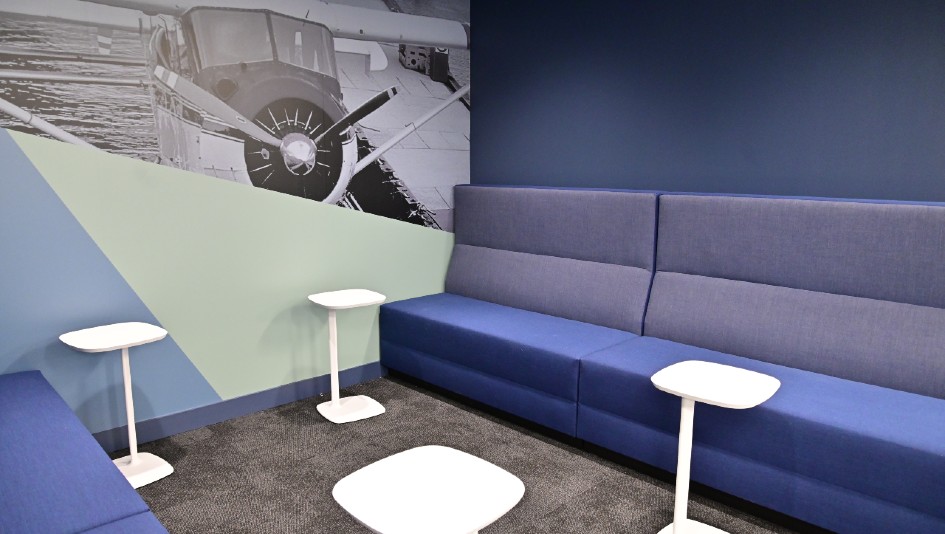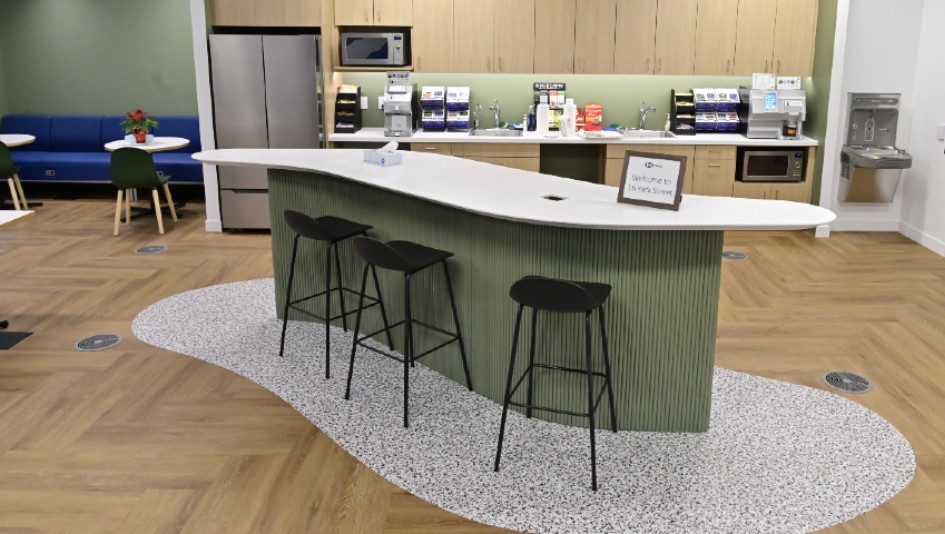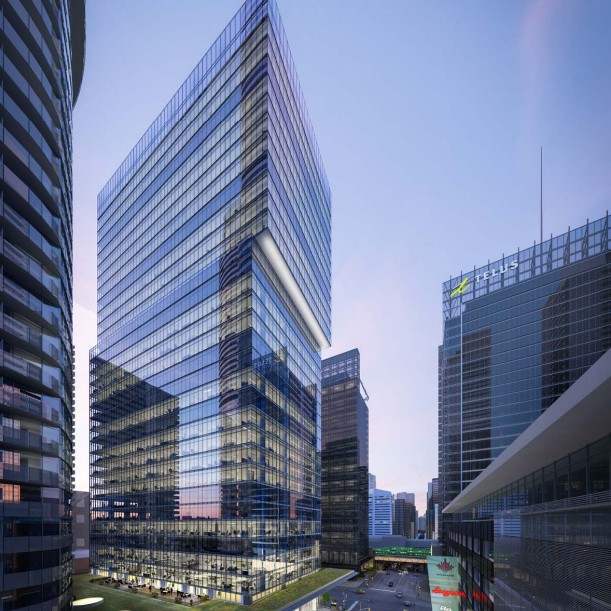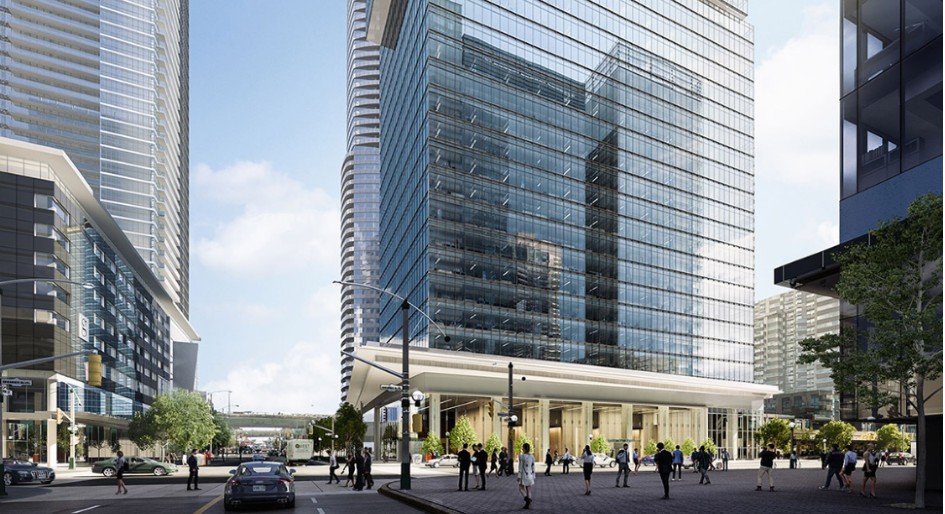On a Friday morning, in HSBC Bank’s new corporate office at 16 York in downtown Toronto, sit-stand desks and meeting rooms are dotted with workers who’ve returned from pandemic lockdowns.
Over the past two years, the global bank has been deciding what post-COVID life should look like for their employees and rebooted into fully-hybrid work arrangements ahead of a March opening in the brand new 33-storey tower.
Occupying floors two to six and more than 5,200 square feet of retail on the main floor, the office suits a revamped collaborative approach for the 1,500 employees who call the office home base. There’s flexible work spaces, no assigned seating, and innovative technology to support teams working around the globe.
One could find Zoom-ready meeting rooms, quiet corners with high-back seating and ventilated booths that automatically close-in for private conversations. Digital white boards at team tables allow multiple users to collaborate in real time from any location, and there is a desk-to-person ratio of 1:3.3, with sit-stand or non-adjustable options.
To make office life easier, an employee experience ambassador is on hand, both in Toronto and the recently renovated national headquarters in Vancouver.
They oversee a rainbow of tasks. A typical day could involve arranging events, fixing IT glitches and assisting with HSBC’s global app, by which employees can book meeting rooms, see when their colleagues plan to be in the office, view building alerts and indoor floor plans, and navigate maps of the local neighbourhood.
Kim Toews, executive vice president and head of human resources, describes the ambassador role as people whose sole job is to “make the office a positive experience,” similar to hotel concierges.
“We wanted to make sure employees felt we are really focused on them and it’s not just about the business and being productive and cost-effective; this is very much about the employee experience,” she says, over a Zoom chat from one of HSBC’s meeting rooms in Toronto. “It’s also practical. You can’t expect managers to know all the ins and outs, so centralizing that to one person is very efficient.”

One of the many collaborative work spaces. All floors are themed around Eastern provinces.

Upon entering each floor, communal cafes support worker interactions across the whole office.
The company has long embraced a flexible work policy that the pandemic has since magnified to unexpected levels. Many workers had never spent all five days in the office. There wasn’t a 1:1 desk ratio for every person, as vacations, illness, training, and travel all impacted desk space. As Toews says, “in a cost conscious environment you’re always trying to maximize every dollar spent.”
There’s more choice now, with four work styles based on internal employee surveys: full-time in office; full-time at home; flexible home; and flexible office. Going to the office also has more purpose. Employees revealed they wanted to return to “the stuff they were missing most” like connectivity and creativity.
“It’s not just about coming to the office, sitting down and working; it’s what are you going to do in the office,” says Toews. “We wanted people to tell us how often they think they are going to come in, but the more we talked about it, the more we started working out the kind of spaces and designs we need.”
“This is our best guess of what is going to work. A lot of spaces are flexible, so we can adjust as we see how people are using the space and the demand for different types of styles.”
Space planning has been a hurdle for many companies configuring return-to-office layouts that fit hybrid work models.
In B.C., HSBC’s Vancouver team contracted with WeWork for alternative offices to relieve overflow at other locations, where a lack of space could be a barrier to productivity. “We are actually trying to dedicate more people to spaces there,” says Toews. “That gives us some additional flexibility, where in leases you don’t have that as much.”
The move to 123,000 square feet at 16 York, a designated LEED Platinum, WELL-certified tower designed by architectsAlliance and B+H Architects, was announced in September 2018.
Back then, the glass tower had yet to fully rise on the southwest corner of York Street and Bremner Boulevard, south of Union Station. It had only broken ground in 2017, during a time when the vacancy rate in Toronto was 4 per cent and 1.5 per cent in the south core.
Relocating from 70 York brought opportunities to turn technology up a notch. “The goal was to look at the latest and greatest, not necessarily cutting edge, but to retain the best details about remote working, while still getting the benefits of being face-to-face,” says Toews. “It is very hard if you’re not in a room to feel that connectivity. That was one of the biggest objectives of the technology; to make everyone feel as equal as possible.”
Equity is central to the conversation around hybrid work modes that bring with them a new etiquette of sorts. One tip—not signing off immediately when a meeting ends. A remote participant who can ‘join in the after conversation’ helps with that connectivity, suggests Toews.
It’s also a small way of supporting workers’ psychological well-being, which the pandemic has intensified. Workplaces have traditionally focused on protecting employees from physical harm, but there is strong scientific evidence that depressed mood, anxiety, and burnout can affect their mental health, according to the Canadian Centre for Occupational Health and Safety.
“I cannot emphasize the importance of manager training when it comes to this,” says Toews. “Everyone’s stress levels have gone up significantly. The degradation of our mental health is significant and continues.”
Managers must now oversee staff who are experiencing less patience and rational, cognitive thinking, she explains. The human brain has adapted to high levels of anxiety and stress during the years-long pandemic.
“It has the greatest and most direct impact on employees if a manager knows how to spot someone who is struggling or knows how to alleviate some of that stress,” she says.”We haven’t given managers the right tools in the past; it was more in a crisis moment, as opposed to that ongoing attention to it.”
The company has a wealth of resources like the online LifeSpeak platform for mental health and well-being education and skill-building tools via HSBC University, which help managers create psychologically healthy environments.
Last year, the company boosted mental-health coverage under its employee assistance program to 18 fully-covered counselling sessions per year.
“If a company does not have any kind of employee assistance program, that is job number one because people often don’t want to talk to someone at work about what they’re struggling with,” says Toews. “We also try to destigmatize it as a free service and encourage people to use it, not just when they feel they are having a breakdown.”
There’s a lot to smooth out for any company surfacing from the throes of the pandemic and mental health awareness figures prominently into the equation, as is rolling out a fully-enabled hybrid workforce.
“We’ve proven we can all work remotely. . . we had really great results last year from a business perspective,” says Toews. “As the organization truly buys into it, and as employees are really forgiving while we all try to figure this out, I think this will result in a much better place.”

16 York. Looking north on York Street, with a green roof. Photo via Cadillac Fairview.





